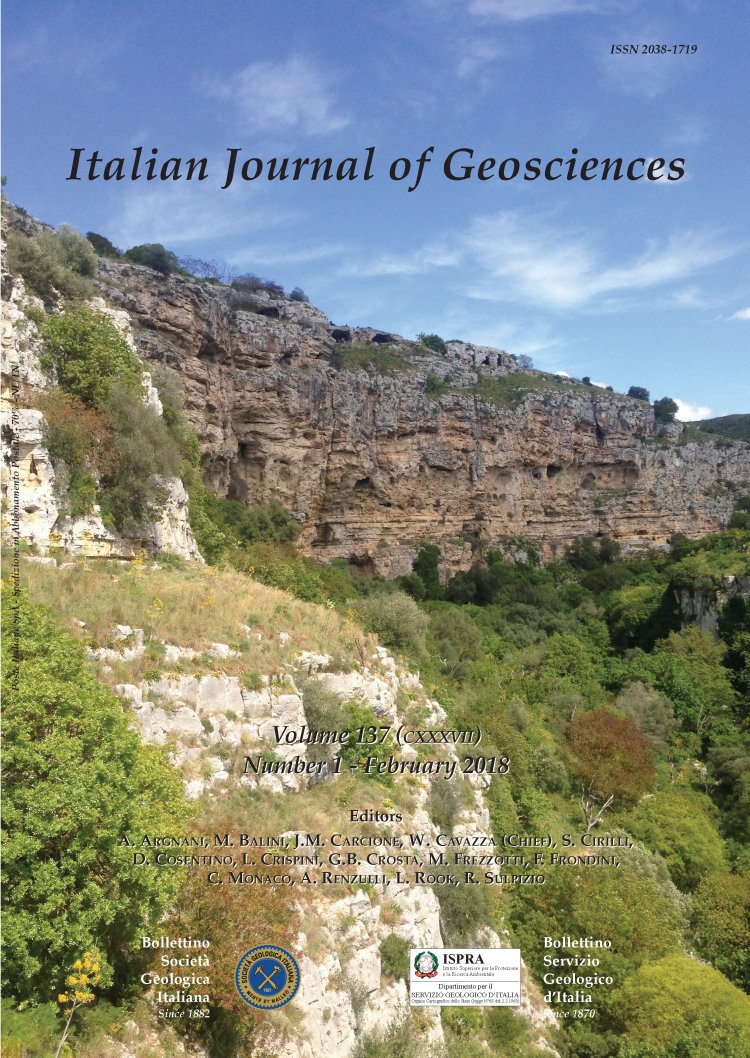
Riverine influence in Sr isotope ratio of mollusk shells and relationship with foraminiferal assemblages in a Late Quaternary succession of the Po River Delta (Northern Italy)
Francesca Castorina (*) & Stefano Claudio Vaiani (**)
(*) Dipartimento di Scienze della Terra, Università di Roma ''La Sapienza'', Piazzale Aldo Moro 5, 00185, Rome, Italy; email: francesca.castorina@uniroma1.it. (**) Dipartimento di Scienze Biologiche, Geologiche e Ambientali, Università di Bologna, via Zamboni 67, 40126, Bologna, Italy; voice +39 (0)51 2094526; fax +39 (0)51 2094522. Corresponding author e-mail: stefano.vaiani@unibo.it.
Volume: 137 (2018) f.1
Pages: 31-37
Abstract
The freshwater influence in the 87Sr/86Sr ratio of mollusk shells were analyzed within a Late Quaternary subsurface succession of the Po River Delta (core 187-S1). Sr isotope ratios of the Po and others rivers' (Brenta, Adige and Reno) waters, discharging in the Adriatic Sea, at about 30 km North and South of the Po Delta, show a domi¬nant contribution in the core area of fluvial water with isotope ratios remarkably lower than seawater values.
Core 187-S1 consists of continental deposits formed during cold-climate periods, with intercalated two paralic to shallow-marine intervals indicative of warm-climate conditions and attributed to the last interglacial (Eemian) and to the Holocene period. Foraminiferal assemblages of these intervals reveal a comparable transgressive-re¬gressive palaeoenvironmental evolution and great variation in river discharge, with highest influence of freshwater observed in the Hol¬ocene prodelta.
The new Sr isotope ratios from marine and deltaic mollusks are commonly comparable with those of seawater and are not influenced by freshwater dilution, also in beach ridge samples, deposited at very shallow water depth. Excluding two anomalous ratios from the trans¬gressive part of the Holocene succession, deviation from marine val¬ues toward lower ratios (consistent with remarkable influx of river water) are observed in samples with foraminiferal assemblages indic-ative of inner prodelta and great proximity of the river mouth.
This work shows that combining foraminiferal micropalaeon¬tology and Sr isotope data of freshwater draining the analyzed are¬as, it is possible to recognize conditions (i.e. deltaic settings greatly influenced by fluvial water with low 87Sr/86Sr ratio) that hamper the application of the Sr isotope ratios as dating tool for shallow marine fossils.
Core 187-S1 consists of continental deposits formed during cold-climate periods, with intercalated two paralic to shallow-marine intervals indicative of warm-climate conditions and attributed to the last interglacial (Eemian) and to the Holocene period. Foraminiferal assemblages of these intervals reveal a comparable transgressive-re¬gressive palaeoenvironmental evolution and great variation in river discharge, with highest influence of freshwater observed in the Hol¬ocene prodelta.
The new Sr isotope ratios from marine and deltaic mollusks are commonly comparable with those of seawater and are not influenced by freshwater dilution, also in beach ridge samples, deposited at very shallow water depth. Excluding two anomalous ratios from the trans¬gressive part of the Holocene succession, deviation from marine val¬ues toward lower ratios (consistent with remarkable influx of river water) are observed in samples with foraminiferal assemblages indic-ative of inner prodelta and great proximity of the river mouth.
This work shows that combining foraminiferal micropalaeon¬tology and Sr isotope data of freshwater draining the analyzed are¬as, it is possible to recognize conditions (i.e. deltaic settings greatly influenced by fluvial water with low 87Sr/86Sr ratio) that hamper the application of the Sr isotope ratios as dating tool for shallow marine fossils.
Keywords
Get Full Text Supplementary Material